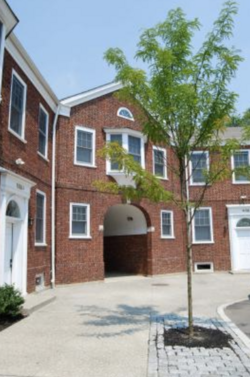Yorkship Village
| Fairview | |
|---|---|
| Neighborhood of Camden | |

A memorial in Fairview, surrounded by residential buildings
|
|
| Nickname(s): Yorkship Village | |
| Coordinates: 39°54′22″N 75°6′21″W / 39.90611°N 75.10583°WCoordinates: 39°54′22″N 75°6′21″W / 39.90611°N 75.10583°W | |
| Country | United States |
| State | New Jersey |
| County | Camden |
| City | Camden |
| Elevation | 20 ft (6 m) |
| Time zone | Eastern (EST) (UTC-5) |
| • Summer (DST) | EDT (UTC-4) |
| ZIP code | 08104 |
| Area code(s) | 856 |
| GNIS feature ID | 0881986 |
|
Fairview Historic District
|
|
 |
|
| Location | Hull Rd and Olympia Rd.; Mount Ephraim Ave.; Crescent Boulevard; North-South Freeway Camden, New Jersey |
|---|---|
| Area | 225 acres (0.91 km2) |
| Built | 1918 |
| Architect | Electus Darwin Litchfield |
| NRHP Reference # | 74001157 |
| NJRHP # | 910 |
| Significant dates | |
| Added to NRHP | November 1, 1974 |
| Designated NJRHP | July 1, 1974 |
Fairview, originally called Yorkship Village, is a neighborhood located in the southern part of Camden, New Jersey. According to the 2000 U.S. Census, Fairview has a population of 5,947. Much of the neighborhood is part of a historic district listed on the state and federal registers of historic places.
The neighborhood was a federally funded World War I planned community of approximately 1000 homes located near New York Shipbuilding of Camden, New Jersey, and was intended to provide housing for the shipyard's workers and their families. New York Shipbuilding had more than tripled in size due to war contracts, and the influx of shipyard workers was overwhelming the Camden housing market. The United States Shipping Board through its Emergency Fleet Corporation used funds from a $50,000,000 appropriation for housing to alleviate a housing shortage threatening its shipbuilding program. Actual construction was managed by the Department of Housing and Transit, United States Shipping Board, Emergency Fleet Corporation which selected Electus Darwin Litchfield as architect.
The site chosen was just upstream from the shipyard on the South Branch of Newton Creek. The 225-acre (0.91 km2) parcel, then located in Haddon Township, had formerly been the Old Cooper Farmstead. The village's design was influenced by the "garden city" developments popular in England at the time.
...
Wikipedia

